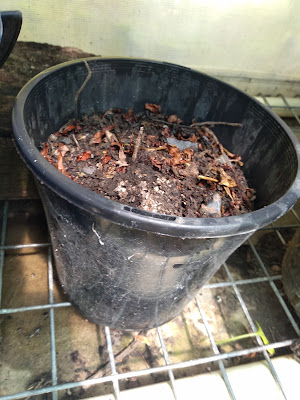Chinese water chestnuts (Eleocharis dulcis) are a perennial vegetable that are incredibly simple to grow. I wrote a post about growing water chestnuts in a bucket. It is simple and the yield was exceptional. Each bucket often gives me a dozen or so edible size corms, and well over a hundred smaller ones to replant. You could eat the small ones, but I find them too fiddly to peel.
I grow duck potatoes (Sagittaria sp) in the same way. They are just as simple to grow, and while the yield was nowhere near as large as water chestnuts the duck potatoes also give a great yield for a small amount of space.
I am told duck potatoes are better suited to cooler climates than water chestnuts, but I find they both perform much the same even in the Canberra region. Chinese water chestnuts are dormant over winter, so are not impacted by frosts. I tend to leave some in the soil and as long as it doesn't freeze solid some always survive to grow the following season. Below are photos of plants in my greenhouse where they are protected from frosts, until this year I have only grown them outside next to the fence where the water is covered in ice regularly over winter.
To grow them I would fill a bucket a bit over 3/4 full with soil and leaf litter. Plant a water chestnut into this. Then add water until it over-flowed. I would put this in the sun, top up the water as needed, and harvest in autumn after the foliage died off. Gardening really doesn't get much easier than this.
The buckets would last about 4 years before they would start to fall apart. Some lasted a lot longer, I still have some that have not yet fallen apart.
Recently I started to wonder why some buckets degraded at 4 years, and others are still going after ten years. I think the bucket degrades slightly from the sunlight and becomes brittle, but is able to stay together because there is no stress placed on the sides. When I harvest I think I must put too much pressure on the bucket and it falls apart. The ones that have not fallen apart are the ones I have been very careful of when harvesting.
These buckets are very cheap (less than $1 each), so this isn't about money, I don't want to be wasting plastic if I can help it.
This year I am trying something a bit different. I am submerging a pot of soil in the bucket of water. Come harvest time I can lift the pot out, harvest what I want, and return the pot, all without stressing the bucket. I think it should work, and it should make harvest easier for me.
Below are photos of what I am trying.
I got a cheap 10 liter bucket, and a slightly smaller pot. The bucket is the cheapest I can find, the pot was given to me second hand. I already have water chestnut corms, and I use soil that I dug out of the drain in front of my garage, so it is not a huge financial expense.
 |
| 10 L bucket and the pot |
 |
| Fill the pot with soil |
 |
| Pot of soil submerged in bucket |
 |
| Water chestnuts ready to grow |
Keep an eye on my blog as I plan to update how having a pot in a bucket works (or doesn't work) for growing water chestnuts and duck potatoes.
If you want to grow water chestnuts in a bucket, it is far easier than you may think. The most difficult part is being able to buy the plants. I have a for sale page where I sell water chestnuts and duck potatoes and other perennial vegetables in Australia. I update the page regularly, and it has my email address that you can use to contact me.


No comments:
Post a Comment